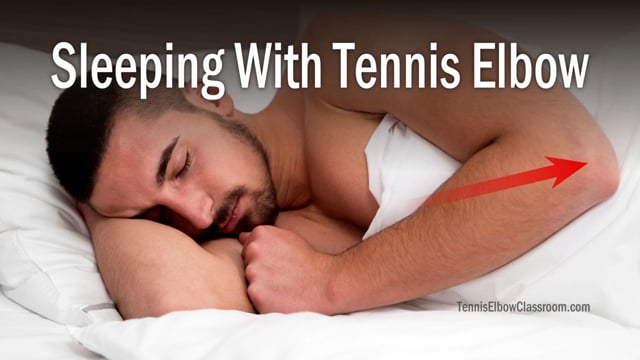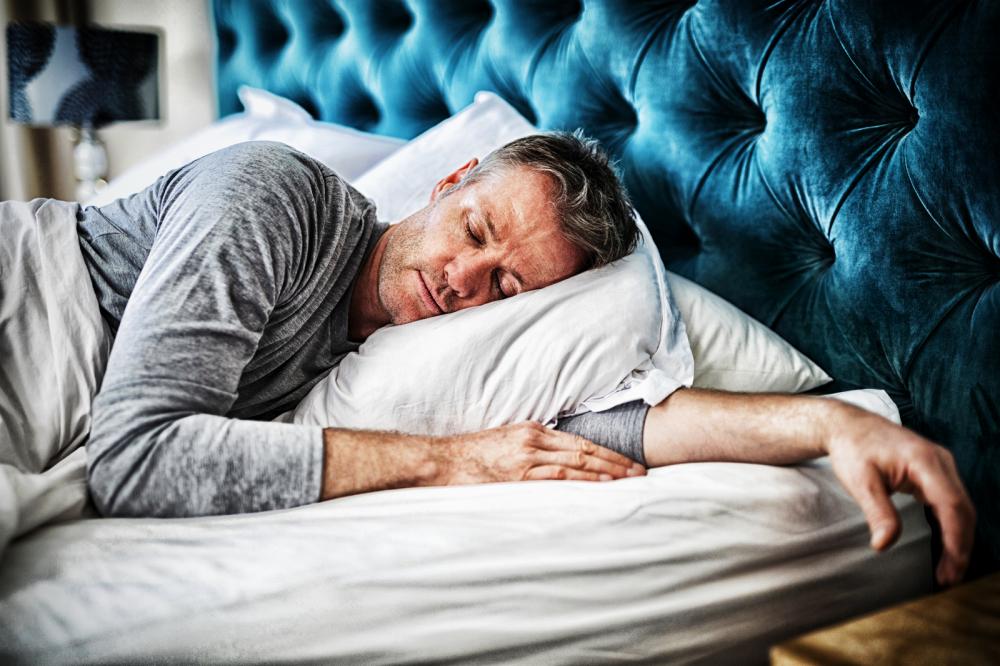How to Sleep With Tennis Elbow
To sleep with tennis elbow, it is important to manage the pain and minimize any stress or strain on the injured area. Start by avoiding activities that exacerbate your symptoms such as gripping objects or lifting heavy items. Ice the affected area for 15-20 minutes several times a day and take over-the-counter nonsteroidal anti-inflammatory medications like ibuprofen to help reduce inflammation and pain.
Use an arm brace at night while sleeping if needed for added support and protection from further injury. Make sure you are using a firm mattress and elevate your arm above your heart level when lying down so that gravity can help relieve pressure from the injured area. Also, consider switching to side sleeping instead of stomach or back sleeping as this can put additional strain on your elbows when extended throughout the night.
- Consult a Doctor: Before attempting to sleep with tennis elbow, it is important to consult a doctor for diagnosis and treatment
- A physician can evaluate your condition and provide personalized recommendations for managing the pain associated with tennis elbow
- This may include rest, physical therapy, medication, or injections
- Use Ice: Applying ice to the affected area of the arm a few times per day can help reduce swelling and inflammation associated with tennis elbow
- Try icing the area before bedtime as well to maximize its effectiveness throughout the night
- Sleep on Your Back: When sleeping with tennis elbow, you should try your best to sleep on your back or side instead of your stomach if possible since this will place less strain on the involved muscles in your arm
- It is also helpful to keep a pillow between your arms when lying down so that there isn’t any pressure from one arm onto another which could aggravate symptoms further during sleep time
- 4 Elevate Your Arm: Elevating your affected arm while sleeping can also be beneficial for relieving some of the discomfort caused by tennis elbow by reducing swelling in that particular joint
- Consequently, make sure that you use pillows or foam wedges under both arms so they are kept elevated above chest level while you are resting at night

Credit: tenniselbowclassroom.com
Why Does Tennis Elbow Hurt More While Sleeping?
Tennis elbow is a common condition that causes pain and discomfort in the elbow joint. It’s caused by repetitive motions of the arm, wrist, or hand, but can also be caused by heavy lifting or even carrying a heavy object. The pain from the tennis elbow may start as a dull ache and then become sharp when pressure is applied to the area affected.
While it’s normal for tennis elbow to cause some level of discomfort during activities like writing, typing, or playing an instrument; many people find that their symptoms are worse at night while they sleep. This could be due to several factors including poor sleep posture resulting in increased stress on your elbows joints all night long as well as decreased blood circulation which can lead to reduced muscle recovery time and increased levels of inflammation around the tendons in the forearm causing more severe pain throughout the day.
Can Tennis Elbow Worsen at Night?
Yes, tennis elbow can worsen at night. People who suffer from this condition often find that the pain and tenderness in their arms become more intense as the day progresses, especially during sleep. This is because people tend to move their arms less when they are sleeping, resulting in less movement of the muscles and joints around the elbow joint.
As a result, these areas become stiffer which can cause an increase in pain levels overnight. Another factor contributing to increased discomfort at night is muscle fatigue caused by activity throughout the day which causes inflammation around the joint leading to further irritation of tissues surrounding it. Additionally, some individuals may experience an increase in swelling due to fluid retention during restful hours of sleep.
Therefore, incorporating simple stretches into your daily routine may help reduce stiffness and alleviate pain associated with tennis elbow both during waking hours as well as overnight.
Should You Wear a Tennis Elbow Brace Overnight?
When it comes to tennis elbow, wearing a brace is one of the most important steps you can take in treating and preventing this condition. But should you wear a tennis elbow brace overnight? The answer depends on your circumstances.
Generally speaking, wearing an elbow brace at night is beneficial for those suffering from pain or inflammation associated with tennis elbow. A night-time brace keeps the joint stabilized while sleeping, which can help reduce discomfort and speed up healing time. Additionally, if your doctor has prescribed physical therapy exercises as part of your treatment plan, wearing a brace overnight will help reinforce proper form during sleep so that you are more likely to benefit from the exercise routine when awake.
On the other hand, if you do not experience any sort of pain or discomfort related to tennis elbow then it may not be necessary to wear a brace at night; however, if symptoms arise then consulting with your doctor would be recommended before starting nighttime bracing.
How Can I Get Rid of Tennis Elbow Fast?
If you’re dealing with the pain and discomfort of tennis elbow, it can be frustrating to find a way to get rid of it fast. But fear not! With the right treatment plan and lifestyle changes, you can reduce your symptoms quickly.
The best place to start is by taking an anti-inflammatory medication such as ibuprofen or naproxen sodium. This will help reduce inflammation in the area which can provide immediate relief from pain and inflammation. Additionally, it may be helpful to apply cold compresses directly on the area for 10 – 15 minutes several times per day until you feel better.
You should also rest your arm as much as possible so that there is no added stress or strain on the affected muscles and tendons. Finally, if possible consider using a special type of brace designed specifically for tennis elbow which helps support the joint while limiting movement at night when most people experience their worst symptoms. With these steps in combination with regular stretching exercises targeted at increasing flexibility around your elbow joint, you should see some improvement within a few days!
How I Cured My Tennis Elbow
After months of struggling with chronic pain in my elbow, I was finally able to find relief for my tennis elbow. Through physical therapy and targeted exercises, I was able to strengthen the muscles around the joint and reduce inflammation. As part of this rehabilitation program, I also incorporated a healthy diet full of anti-inflammatory foods like turmeric, ginger, and garlic into my daily routine.
After 6 weeks following this regimen faithfully I began to see significant progress in terms of lessening pain levels as well as increased mobility in my arm and shoulder.
Positions to Avoid With Tennis Elbow
Tennis elbow is a painful condition that affects the tendons in your forearm. It’s important to be aware of certain positions and movements that can aggravate this condition, to avoid causing further pain or injury. To minimize the risk of developing tennis elbow, it is best to avoid activities that involve repetitive motions such as extended typing on a computer keyboard, gripping tools for long periods, or extending your arm too far out away from your body when lifting heavy objects.
Additionally, any activity involving sudden jerks or twists should also be avoided if you have been diagnosed with tennis elbow.
Tennis Elbow Keep Arm Straight Or Bent
When playing tennis, it is important to keep your arm straight when hitting the ball to reduce the risk of developing a tennis elbow. Keeping your arms bent can put additional strain on the muscles and tendons around your elbow joint, which can lead to pain and inflammation. If you do bend your wrist during a shot, make sure it is done slowly and not with an excessive amount of force.
Additionally, if you are suffering from any symptoms related to tennis elbow (such as pain or stiffness), rest for at least 24 hours before resuming play.
Best Tennis Elbow Brace for Sleeping
If you suffer from tennis elbow, a sleeping brace can help provide relief and support for your arm while you rest. The best type of brace to wear overnight is a padded night splint that keeps your wrist in an extended position while keeping the forearm muscles relaxed. This prevents further strain on the joint, allowing it to heal more quickly.
Additionally, look out for braces with adjustable straps so you can tailor them to fit snugly and comfortably against your body as you sleep.
Conclusion
If you are someone who is suffering from tennis elbow, it can be difficult to get a good night’s sleep. However, with the right strategies and precautions in place, you can help mitigate your discomfort at night. You may want to consider investing in an orthopedic pillow or mattress that will provide better support for your arm while sleeping.
Additionally, stretch and exercise during the day can help reduce tension in the affected area which could lead to more restful sleep. Taking these steps can go a long way toward helping you achieve much-needed relief!



